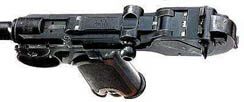The Luger's direct ancestor, the Borchardt C/93 self-loading pistol, was one of the very earliest viable semiautomatic pistols available in any quantity. It was designed by Hugo Borchardt while employed by Ludwig Loewe & Co, Karlsruhe, Germany.
This weapon, which began production in 1894, was only a marginal commercial success. It operated on the principle first defined by Hiram Maxim, of using the backward thrust of a fired cartridge to reload and recock the weapon.
 It fired from a locked breech system later made famous by Luger, which worked roughly on the principle of the human knee-joint. When it was straight and locked, it was virtually un-movable, but as soon as the joint was pushed upward it opened easily and smoothly. When the cartridge was fired, the recoil drove back the barrel and bolt until lugs on the receiver caused the joint to rise, allowing it to break free. The barrel then stopped, but the bolt continued to the rear, compressing a return spring. When the bolt's rearward energy exhausted, the compressed spring drove it forward again, stripping a round from the box magazine in the butt and chambering it ready for the next shot.
It fired from a locked breech system later made famous by Luger, which worked roughly on the principle of the human knee-joint. When it was straight and locked, it was virtually un-movable, but as soon as the joint was pushed upward it opened easily and smoothly. When the cartridge was fired, the recoil drove back the barrel and bolt until lugs on the receiver caused the joint to rise, allowing it to break free. The barrel then stopped, but the bolt continued to the rear, compressing a return spring. When the bolt's rearward energy exhausted, the compressed spring drove it forward again, stripping a round from the box magazine in the butt and chambering it ready for the next shot.
This was the first time such a principle had been applied to a pistol; it worked well, but the weapon was expensive to make, since it called for fine workmanship and the use of very high quality steel, especially for the manufacture of the joint pins. The weapon was also very bulky, and thus was practically impossible to fire with one hand. To overcome this difficulty, it was provided with a strong and well-fitting stock. In fact, it was generally considered more as a light carbine than as a pistol.
